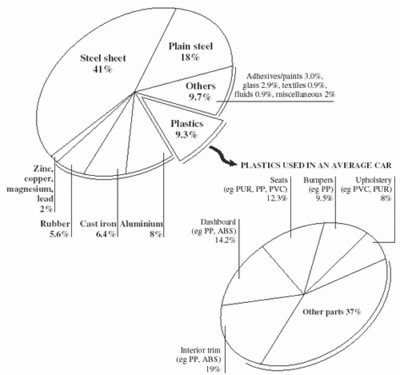
The automotive End-of-Life Vehicle (ELV) process in the EU is well documented and researched. The legislation in the EU implemented in the ’90’s and 2000’s is directed towards reducing the Automotive shredding Residue, all what is left after recycling and highly toxic, towards less then 5% to be landfilled. The automotive industry is responsible for taking care of the disposal and have to take the car back for free. At this point about 75% of the ELV is recycled in the EU the rest ends up in landfills this should be reduced to 5% by 2015. that is below the 2006 target of 80% recovery and 85% recycling, only Sweden and the Netherlands achieved the targets.
The average composition of the E.U. car in 1998, the car that will be recycled and shredded now, is illustrated on the left, which clearly shows the increase of aluminum content (~8%) in the total car weight. Ferrous and non-ferrous metals (Zn, Cu, Mg, and Pb) constitute about 67.5% of the vehicle. This figure also depicts the plastics used in average cars (~9.3%), their applications in the car body, and the major type of plastic used (polyvinyl chloride, polypropylene, polyurethane rubber, etc.).
The last car owners (i.e., users) are the starting point for the ELV chain. After de-registering the vehicles, the users canglass deliver their old cars to the dealers and/or to used-car dealers. The dealers, in turn, deliver the used cars to collectors/dismantlers. The deregistration of used cars can be done by users, dealers, collectors, and/or dismantlers, depending on the county rules. This is in total about 9 mio. cars/year including the ones that still drive and are exported to non-EU countries like Africa, former USSR etc.
Collecting and dismantling companies focus on removing valuable spare parts and other components such as engines, batteries, oils and fuels, and airbags. Although these companies are essential to the reduction of ELV waste, they are small companies that are mostly interested in ELV parts that are suitable for reuse, recycling, or sale. The ELV dismantling is often done improperly which increases the amount and toxicity of ELV waste. After dismantling the hulks, the remainders of the ELV, are shredded by shredding companies.
After the hulks are shredded, the obtained materials undergo a series of mechanical and physical separations in order to recover the ferrous and non-ferrous metals. The residual of the shredding process, automobile shredder residue (ASR), represents about 20–25% of the ELV weight. Of this 75% of the weight is combustable (resins, PU, Rubber, Wood, paper, fabric) 25% is metal and glass. ASR of the disposed cars amount to 2 million tons of waste in the EU alone.
So how to improve? What value can designers add?
In 2005 Bernardete Castro was promoted on design for resource efficiency with a focus on Automotive. She inventoried which material combinations can be recycled together without down-cycling. She further developed the Synapse design tool which gives design guidelines based on resource efficiency of a product/component and a specific situation to improve the resource efficiency.
Examples;
A few key improvements for higher degree of recovery;

Comments by our Users
Be the first to write a comment for this item.